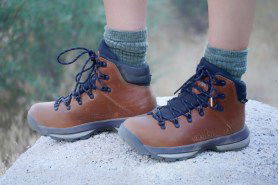

It’s still fall, but several high-elevation spots are already getting their first inches of snow. And as the snow falls, and temperatures drop, ice climbers around the world are getting ready to take on the mountains. It’s not a sport to take lightly, but if you’ve always wanted to give ice climbing a try, but you don’t know where to start in terms of gear – well, now is the time to change that. Here is the key gear you’ll need for your first ice-climbing adventure.
This post contains affiliate links. Outdoors.com may earn a commission when you make a purchase through these links. Thank you for your support.

Step 1: The Basics

Once you’ve fallen in love with ice climbing after taking lessons, you’re going to need to start gathering your own gear. Make sure you start with safety, pick up a climbing helmet, like this one from Black Diamond. The Vapor is great because it is lightweight, keeping you light on your climbs (plus it’s currently 50% off). You’ll also want to find a great and reliable harness that will be comfortable and breathable when you’re out on the mountain.
Similarly to rock climbing, ice climbing requires ropes, and they come in different sizes and widths. Make sure you find one that feels right for you, is dry-treated, and is UIAA-tested to be safe for falls.
Another important basic is a good – no, a great – pair of climbing shoes. This pair from Butora has a fuse sticky rubber outside and a natural hemp lining that will keep you comfortable when you’re hanging on the side of the mountain.
And as is the case for most great adventures, you’ll want to have a sturdy backpack that can hold all of your extra gear, snacks and anything else on your way to the climbing site.
Step 2: Important Gear to Keep in Your Pack

Pack extras. Extra ropes, extra socks, extra gloves, extra carabiners, and extra pulleys. The colder, the wetter, the more relieved you’ll be to have more gear, not less. You’ll also want to ensure that you have belays and rappels available to you to ensure a safe descent down the rope. For safe measures, you can also pack some cords in your backpack to ensure that you have extra rope.
Step 3: Dress for the Occasion

When it comes to climbing in any weather, it is important to note that the higher you get, the cooler it will become. Put on your favorite base layers to prepare for your chilly adventure. Make sure you have a good pair of wool socks to keep your feet warm and treat your hands to up a good pair of rappelling gloves. A sturdy, but lightweight hard shell will also keep you warm when you’re climbing up the side of a cold, icy mountain.
Ice climbing is an intense, and potentially very dangerous activity if you aren’t fully trained, prepared, and focused. Make sure you’re ready to go with proper lessons, conditions, and the top equipment.









